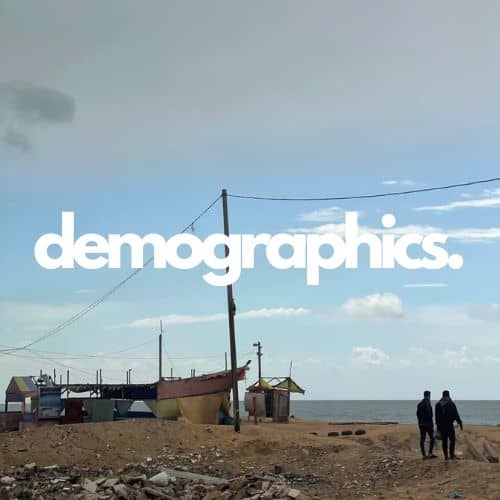Gaza’s population of approximately 2.3 million people is diverse despite the occupation and siege imposed upon the enclave.
For readers curious about the Gazan population and its characteristics, this is the page for them. This page is dedicated to the demographics of Gaza. While figures are shared, we consider it important that demographics are presented with cultural context. Gaza is quite diverse despite technically being a monoethnic society and this page is dedicated to sharing the demographics of Gaza with this in mind.

The Gaza Strip has been oft-called one of the most densely populated areas globally. Approximately 70% of the Strip’s population are refugees, many of whom reside in one of Gaza’s eight refugee camps. The overwhelming population density stems from historical events like the Nakba, which displaced between 750,000 to one million Palestinians, with a significant number seeking refuge in Gaza. Gaza’s small but popular coastal city pre-Nakba has a population of 80,000 yet with the forced displacement of the Palestinans some 200,000 people sought refuge in Gaza.1
The terms “la’jieen” and “muhajareen” are used in Gaza to refer to refugees, while the Strip’s original inhabitants are known as “muwatineen.”
You should know: The term “usli/asli” is not used in the Gaza Strip to refer to the non-refugee residents as some other sources note.
Some 1.7 million people, the mass majority of current-day Gazans, are the descendants of refugees. Approximately 1.5 million of such individuals are registered refugees with UNRWA. Even if they may be “Yafans,” they are also “Gazans” (of the Strip)—still, in Gaza, it would be known if Gazans are muwatineen/“Gazan Gazans” or la’jieen/muhajireen. Both la’jieen and muhajireen are used colloquially; however, based on the linguistic and legal definitions of the terms, laji’een is considered the more proper word to use. Furthermore, some Gazans even note the importance of replacing both more popular terms with the word “naziheen.”
In Gaza, there are eight refugee camps: Jabalia Camp, Beach “Shati” Camp, Nuseirat Camp, Bureij Camp, Maghazi Camp, Deir El-Balah Camp, Khan Younis Camp, and Rafah Camp. Two of the camps are in the northmost governates, four are in the middle area (Central Gaza), and two are in the southmost governates. These camps are characterized by narrow streets, alleys, and short, dilapidated buildings and several are amongst the most densely populated areas in the world.2 It is important to note that many of the world’s other most densely populated areas are city centers with highrises and skyscrapers that can comfortably house many residents; Gaza’s refugee camps are in no way similar.
Gaza has a relatively balanced distribution, with women comprising approximately half of the population. While traditional gender roles are prevalent in Gazan society, women actively participate in various sectors, including education, healthcare, and public administration.
In Gaza, age demographics paint a picture of an especially young population. With an estimated average age of 19 in 2023,3 Gaza is among the countries with the youngest median age. With an astonishingly significant portion of the populace under the age of 25, the youth of Gaza undeniably constitute a driving force behind the region’s energy and aspirations.
However, amidst this youthful vigor lies a stark reality: approximately 40% of the “youth” are 14 and under.4 No matter their energy and aspirations, they are young children and cannot contribute to the economy in impactful ways.
To add fuel to the fire, most Gazans have never experienced life outside the confines of siege. From early childhood to adulthood, the backdrop of conflict and blockade shapes their existence. Despite their young age, many are all too familiar with the harsh realities of limited resources, restricted opportunities, and the constant specter of instability and war. Fortunately, Gazans are known to develop resilient spirits in the face of the adversities they face and many have come up with creative ways to address the local unemployment issue.
References
- From the 1948 Nakba to the 1967 Naksa. BADIL Resource Center for Palestinian Reisdency and Refugee Rights. (2004, June). https://www.badil.org/phocadownloadpap/Badil_docs/bulletins-and-briefs/Bulletin-18.pdf ↩︎
- The Economist Newspaper. (2023, November 2). Why Gaza’s refugee camps are so vulnerable. The Economist. https://www.economist.com/interactive/the-economist-explains/2023/11/02/why-gazas-refugee-camps-vulnerable-jabalia ↩︎
- Central Intelligence Agency. (n.d.-b). Median Age. The World Factbook. https://www.cia.gov/the-world-factbook/field/median-age/country-comparison/ ↩︎
- Central Intelligence Agency. (n.d.). Age Structure. The World Factbook. https://www.cia.gov/the-world-factbook/field/age-structure/ ↩︎
